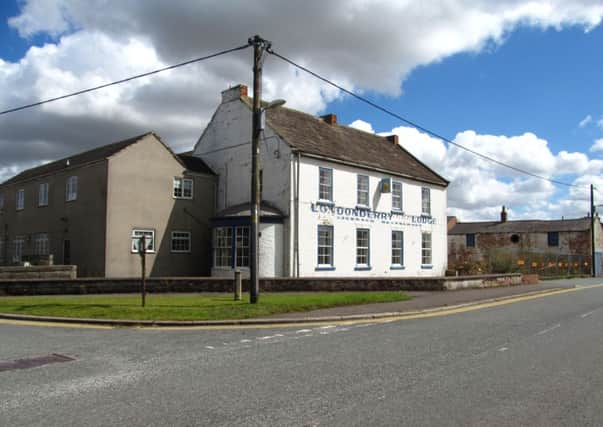Londonderry... North Yorkshire that is


His memories of travelling in England with the TA and through north Yorkshire on his way to training sessions with his fellow soldiers, discovering there was a ‘Londonderry’ and ‘Moscow’ a mere mile apart in the north England Shire, inspired a bit of research.
A bit of trawling around on the Internet produced a short article and a ‘lead’ in the form of a gentleman called Gordon Hatton, who lives not far away from Londonderry.
Advertisement
Advertisement
A few emails were exchanged, and Mr Hatton very kindly provided us with photographs of his Londonderry for us to share with the Londonderry Sentinel readership.


According to Mr Hatton there’s not a lot to say about the Yorkshire Londonderry as there’s not a lot there...
A frequent joke here is that the best thing out of Londonderry is the A5. Well, in Londonderry, North Yorkshire the A1 is just west of the village and cuts it off from all through traffic. The road was upgraded from a dual carriageway in 2011.
The Londonderry Garage, pictured here, sees very little passing trade, says Gordon, but he surmises that it is probably kept going by truckers and people going to and from the local transport yard.
Advertisement
Advertisement
Another of Gordon’s photographs shows the rather quaint ‘Londonderry Lodge’ According to him it used to provide accommodation mostly for truckers, but has been closed for at least three years now due to a lack of trade.
“The road sign, which points the way to Londonderry is now out of date as there is no access to the A1 north along the road to the right. It is just one of several misleading signs near the upgraded A1,” he said.
As for the village of Londonderry itself, Gordon has taken a few snaps of the village street.
The Old A1, at the south end of the village, is where the old single carriageway A1 road comes to a dead end. The new motorway is beyond.
Advertisement
Advertisement
There are a number of old ‘estate buildings’ which look like old agricultural buildings which may have once belonging to the Newton Hall estate. They are now used as offices for a transport firm. There is also the ‘old smithy’ and Gordon says that the Londonderry blacksmiths and forge must be the oldest business in the village, as it appears on maps from the 1860s.
Another photograph he kindly sent is of RAF Leeming. It was built as a WW2 bomber base on land belonging to Newton Hall and in the background of the photograph is Hambleton Hills (North York Moors National Park) in the distance.
His photographs are accompanied by the following narrative: “Londonderry is a tiny village of less than 50 houses situated in the middle of the fertile Vale of Mowbray with the North York Moors to the east and the Yorkshire Dales to the west. At one time it would have been busy with travellers on the Great North Road, the A1, but now it is a quiet backwater on the road to nowhere.
“Where does it get its name? No one seems to know exactly why it is called Londonderry. There is a theory that the name comes from the Marquis of Londonderry who had extensive estates in the North East, mostly in Co Durham where he owned coalfields and developed the port of Seaham Harbour, but there seems to be no direct link between the family and this village,” he said.
Advertisement
Advertisement
“In centuries past it was most likely known simply as ‘The Street’. This would make sense as it is on the course of the Roman Dere Street which linked Eboracum (York) with Hadrian’s Wall and central Scotland. The same road through the village later became known as Leeming Lane and developed as one of several versions of the Great North Road between London and Edinburgh. It is often assumed that there was only one Great North Road, but in Yorkshire there were at least three versions, the busier routes being further east from Boroughbridge via Topcliffe and Northallerton towards Darlington, or from York to Darlington via Thirsk and Northallerton as these two routes visited more towns where there were more travellers, plus coaching inns and stables.
“In 1922 the road system in Great Britain was given its first series of numbers and Londonderry was on the A66. A later renumbering put Londonderry on the A1 and so began several decades of traffic rumbling through the village. This continued until the late 1960s when a by-pass was built around Londonderry and Leeming; the A1 being upgraded to a dual carriageway. During this time there was still access from Londonderry to the A1, but since 2011 there has been no access, as the A1 has been upgraded again to a three-lane motorway. The result of this has been to kill off any remaining passing trade. There is still a garage and transport yard, but the nearby Londonderry Lodge which used to offer accommodation has now been closed for three years or more,” said Gordon.
“There is little of note or architectural interest in the village. It has no church, shop (other than a garage kiosk) or school and it doesn’t even get a mention in the ‘Buildings of England’ (North Riding) architectural guides first produced by Pevsner,” he says, adding: “At one time the village had its own ‘big house’ at the north end of the village and known as Newton Hall. Much of its parkland and fields were taken over by the military during World War II and became RAF Leeming, a World War II bomber base. The house itself was used by the military, but went into decline after the war and was eventually demolished. Only a few outbuildings and a lodge cottage still remain.”